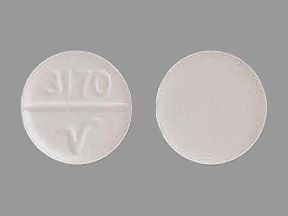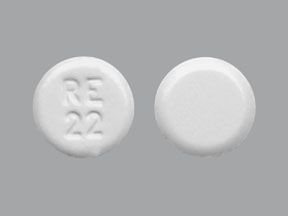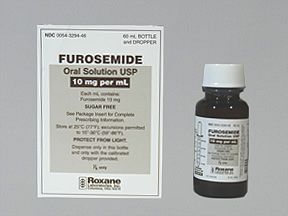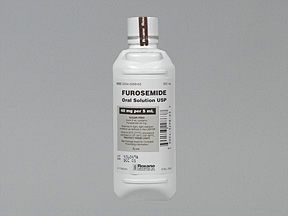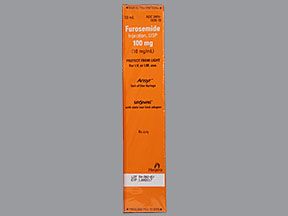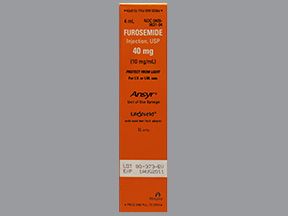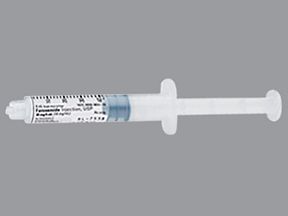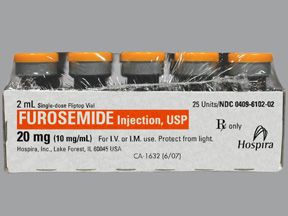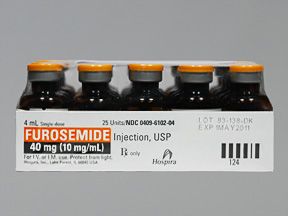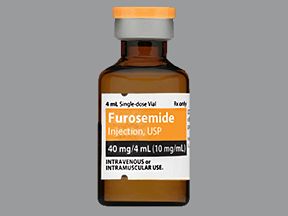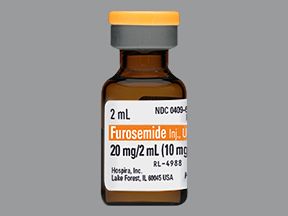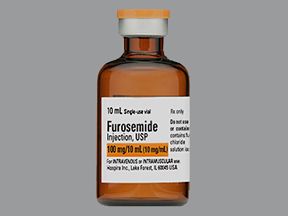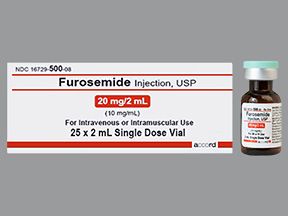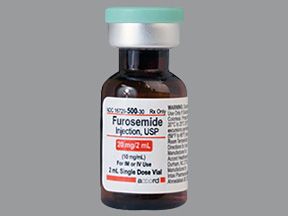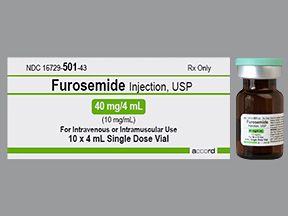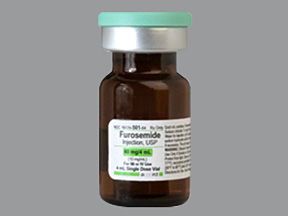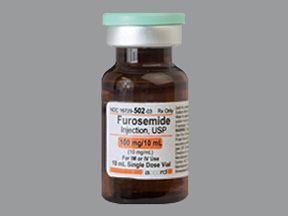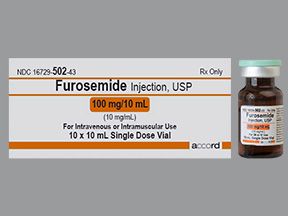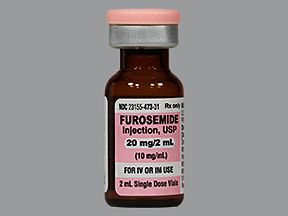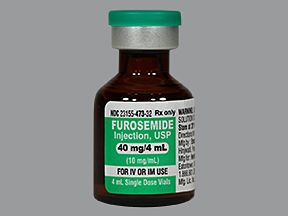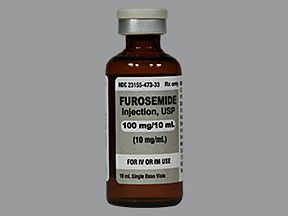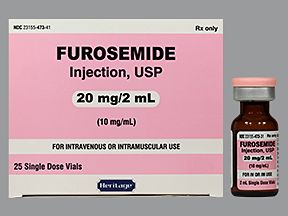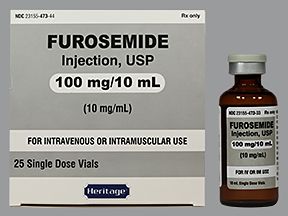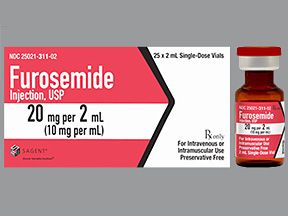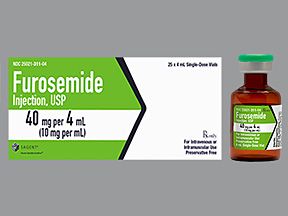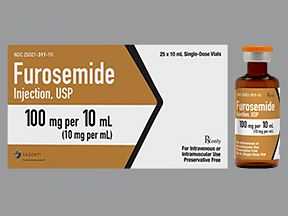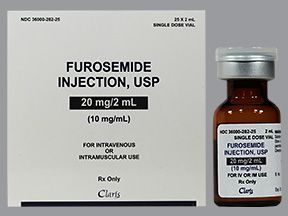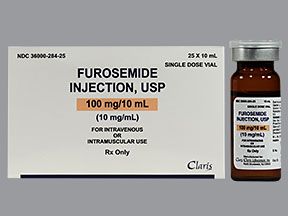If you have high blood pressure or edema (fluid buildup), your doctor may discuss furosemide oral tablets with you.
This is a prescription drug that’s used:
- in adults for high blood pressure
- in adults and some children for edema that’s related to:
To learn more about furosemide’s uses, see the “What are furosemide oral tablets used for?” section below.
Furosemide oral tablet basics
Furosemide is an active drug ingredient. It’s a generic drug that comes as oral tablets that you’ll swallow.
Furosemide is classified as type of diuretic, which are also sometimes called water pills. A drug classification is a group of drugs that work in similar ways.
In this article we’ll discuss the uses, side effects, interactions, and more of furosemide oral tablets.
Note: Furosemide also comes in other forms. It’s available as an injectable and solution that’s taken by mouth. Only furosemide oral tablets are described in this article. If you’d like to learn about other forms of furosemide, talk with your doctor or pharmacist.
Furosemide oral tablet brand-name versions
Furosemide oral tablets are available in a brand-name version called Lasix. To learn about this version, talk with your doctor or pharmacist.
Furosemide oral tablets are a generic drug, which means they’re an exact copy of the active drug in a brand-name medication. The brand-name medication that furosemide oral tablets are based on is called Lasix.
Generic drugs are thought to be as safe and effective as the brand-name drug they’re based on. In general, generics usually cost less than brand-name drugs do.
If you’d like to know more about taking Lasix instead of furosemide oral tablets, talk with your doctor. View this Healthline article to learn more about the differences between generic and brand-name drugs.
Like most drugs, furosemide oral tablets may cause mild or serious side effects. The lists below describe some of the more common side effects that furosemide oral tablets may cause. These lists don’t include all possible side effects.
Keep in mind that side effects of a drug can depend on:
- your age
- other health conditions you have
- other medications you may be taking
Your doctor or pharmacist can tell you more about the potential side effects of furosemide oral tablets. They can also suggest ways to help reduce side effects.
Mild side effects
Here’s a short list of some of the mild side effects that furosemide oral tablets can cause. To learn about other mild side effects, talk with your doctor or pharmacist, or read furosemide oral tablets’ prescribing information.
Mild side effects of furosemide oral tablets that have been reported include:
- diarrhea
- urinating more than usual
- constipation
- dry mouth
- nausea or vomiting
- headache
- dizziness
Mild side effects of many drugs may go away within a few days or a couple of weeks. But if they become bothersome, talk with your doctor or pharmacist.
Serious side effects
Serious side effects from furosemide oral tablets can occur, but they aren’t common. If you have serious side effects from furosemide oral tablets, call your doctor right away. But if you think you’re having a medical emergency, call 911 or your local emergency number.
Serious side effects of furosemide oral tablets that have been reported include:
- dehydration (low fluid level)
- imbalanced electrolyte levels, such as hyponatremia (low sodium level) and hypocalcemia (low calcium level)
- pancreatitis (inflammation in the pancreas)
- liver problems, such as hepatic encephalopathy, which may cause jaundice or increased liver enzyme levels
- tinnitus (ringing in the ears) and hearing loss*
- orthostatic hypotension (low blood pressure that happens upon standing)*
- severe skin reaction*
- allergic reaction*
* For more information about this side effect, see the “Side effect focus” section below.
Side effect focus
Learn more about some of the side effects furosemide oral tablets may cause.
Tinnitus and hearing loss
Studies show that furosemide may increase the risk of some hearing problems. In fact, it can cause tinnitus (ringing in the ears) and hearing loss.
These side effects may be temporary or permanent.
Your risk for hearing problems with furosemide may be higher if you:
- have severe kidney problems
- are taking a higher dose of furosemide
- are taking the injectable form of furosemide rather than oral tablets
- are also taking other drugs that have this side effect
What might help
If you have any hearing problems after starting furosemide, call your doctor right away. They can check your hearing. They can also order certain tests to make sure furosemide isn’t building up in your body.
Your doctor may adjust your dosage of furosemide or switch you to a different drug if needed. In some cases, this drug may not be right for you. Ask your doctor for more information about this side effect.
Orthostatic hypotension
Furosemide can cause a blood pressure condition called orthostatic hypotension. With this condition, your blood pressure drops when you change positions, such as when you stand up. It can be dangerous because it can make you dizzy or cause you to fall.
In serious cases, orthostatic hypotension may make you faint. It can also cause heart problems and other serious issues.
Older adults have a higher risk for orthostatic hypotension. The risk of this condition may also be higher if you’re taking other medications that have this side effect. The risk of orthostatic hypotension is also increased if you’re dehydrated (have a low fluid level) or have an electrolyte imbalance.
What might help
When you first start taking furosemide, be careful when changing positions until you become used to the drug’s effects. Your doctor will check your electrolyte levels and order other blood tests to see how furosemide is working for you.
Talk with your doctor about all of your medications and health history. They can tell you if you have an increased risk for orthostatic hypotension.
If you have orthostatic hypotension with furosemide, ask your doctor what you can do to manage it. In some cases, furosemide may not be the right option for you. If that’s the case, your doctor will discuss other drugs that may work better for you.
Severe skin reaction
Furosemide may
- blisters
- peeling skin
- rash
- hives
- itching
In some cases, the drug can cause a severe skin reaction called Stevens-Johnson syndrome.
Keep in mind that a skin reaction can occur with an allergic reaction to furosemide. To learn more about allergic reaction, see the section just below. If you’re allergic to sulfa drugs, you may also be allergic to furosemide. In that case, your risk for a serious skin reaction may be increased with this drug.
What might help
If you’re allergic to sulfa drugs or have had an allergic reaction to any drugs in the past, tell your doctor. They’ll recommend if you should take furosemide.
If you develop a rash after starting or at any time while taking furosemide, call your doctor right away. They can check to see what’s causing your rash and may recommend ways to treat it.
If your rash feels life threatening, call 911 or your local emergency number right away.
Allergic reactionSome people may have an allergic reaction to furosemide oral tablets.
Symptoms of a mild allergic reaction can include:
- skin rash
- itchiness
- flushing (temporary warmth, redness, or deepening of skin color)
A more severe allergic reaction is rare but possible. Symptoms of a severe allergic reaction can include swelling under your skin, typically in your eyelids, lips, hands, or feet. They can also include swelling of your tongue, mouth, or throat, which can cause trouble breathing.
Call your doctor right away if you have an allergic reaction to furosemide oral tablets. But if you think you’re having a medical emergency, call 911 or your local emergency number.
Your doctor will explain how you should take furosemide oral tablets. They’ll also explain how much to take and how often. Be sure to follow your doctor’s instructions. Below are commonly used dosages, but always take the dosage your doctor prescribes.
Taking furosemide oral tablets
Furosemide comes as oral tablets that you’ll swallow.
It’s available in three strengths:
- 20 milligrams (mg)
- 40 mg
- 80 mg
Furosemide oral tablets meant for use by people don’t come in other strengths, such as 10 mg or 12.5 mg. If you’d like to know more about these strengths, talk with your doctor or pharmacist.
If furosemide oral tablets don’t work well for you, your doctor may prescribe a different form of furosemide for you. They’ll recommend the furosemide strength and form that’s right for you.
Dosage
Your doctor will tell you how much furosemide you can take in a day. Your dosage will vary depending on the condition you’re treating. You can take this drug once or twice a day, based on your condition.
It’s important to follow your doctor’s instructions for administering doses of furosemide. Doing so will best manage your condition and help you avoid side effects.
Your exact dosage of furosemide depends on:
- the condition being treated
- your age
- other health conditions you have
- other drugs you’re taking
Your doctor may start you taking a low dose of the drug to see how your body responds. Then, if you’re doing well with furosemide, your doctor may gradually increase your dose to get maximum benefits.
Taking furosemide oral tablets with other drugs
Your doctor may prescribe furosemide alone or together with other medications for your condition.
For instance, they may prescribe other diuretics, which are also called water pills, with furosemide. This could include spironolactone, which is a potassium-sparing diuretic. (Potassium-sparing diuretics work a bit differently than furosemide does. They remove extra fluid and sodium from your body without making you lose potassium.)
Your doctor may lower your dosage of furosemide if you take it with other drugs that have similar effects.
Talk with your doctor if you’d like to know more about taking furosemide with other drugs.
Questions about taking furosemide oral tablets
Here are answers to a few questions related to taking furosemide oral tablets.
- What if I miss a dose of furosemide oral tablets? If you miss your usual dose of furosemide, take it as soon as you remember. But if it’s close to your next regular dose, don’t double your dose. Just skip the missed dose and take the next scheduled dose. Unless your doctor tells you otherwise, avoid taking furosemide in the evening or at night. This way, it doesn’t interrupt your sleep, since it causes increased urination. If you’re having trouble remembering to take your doses of furosemide, consider using reminder tools to help keep you on track.
- Will I need to take furosemide oral tablets long term? There’s no set timeframe for how long you can take furosemide. Your doctor will monitor how your body is doing with the drug and they’ll discuss long-term treatment plans with you.
- Can furosemide oral tablets be chewed, crushed, or split? Yes, if you have trouble swallowing pills, you can chew, crush, or split furosemide oral tablets. Your doctor may also prescribe a liquid form of furosemide if you have trouble swallowing pills. Ask your doctor for more information about this.
- Should I take furosemide oral tablets with food? You can take furosemide with or without food. Furosemide may cause nausea and vomiting. So taking it with food may help ease nausea. Your doctor or pharmacist can tell you the best time to take the drug for your condition and how to manage its side effects.
- How long do furosemide oral tablets take to work? This drug starts to work within an hour after you take it. Keep in mind that you may need to take it for a few days to weeks before you see your condition improve. Your doctor will order blood tests to monitor how you’re doing with furosemide. This can help you avoid serious problems with the drug and ensure that it’s working well for you.
Questions for your doctorYou may have questions about furosemide oral tablets and your treatment plan. It’s important to discuss all your concerns with your doctor.
Here are a few tips that might help guide your discussion:
- Before your appointment, write down questions such as:
- How will furosemide oral tablets affect my body, mood, or lifestyle?
- Bring someone with you to your appointment if doing so will help you feel more comfortable.
- If you don’t understand something related to your condition or treatment, ask your doctor to explain it to you.
Remember, your doctor and other healthcare professionals are available to help you. And they want you to get the best care possible. So don’t be afraid to ask questions or offer feedback on the treatment of your condition.
Before starting furosemide, talk with your doctor about all of your health conditions and any medications you’re taking.
These and other considerations are described below.
Interactions
Taking medications, vaccines, foods, and other things with a certain drug can affect how the drug works. These effects are called interactions.
Before taking furosemide oral tablets, be sure to tell your doctor about all medications you take, including prescription and over-the-counter types. Also describe any vitamins, herbs, or supplements you use. Your doctor or pharmacist can tell you about any interactions these items may cause with furosemide oral tablets.
Interactions with drugs or supplements
Furosemide oral tablets can interact with several types of drugs. These drugs include:
- the seizure drug called phenytoin
- certain antibiotics, such as neomycin, gentamicin, vancomycin, amphotericin B, and tobramycin
- the cancer drugs cisplatin and methotrexate
- diuretics other than furosemide, such as ethacrynic acid
- angiotensin converting enzyme inhibitors, such as benazepril, captopril, enalapril, and lisinopril
- angiotensin II receptor blockers, such as candesartan, losartan (Cozaar), and irbesartan (Avapro)
- the mental health condition drug lithium
- the immunosuppressant drug cyclosporine
- aspirin and nonsteroidal anti-inflammatory drugs (NSAIDs), such as indomethacin
- thyroid hormone medications such as levothyroxine
- the heart medication digoxin
This list does not contain all types of drugs that may interact with furosemide oral tablets. Your doctor or pharmacist can tell you more about these interactions and any others that may occur while taking furosemide oral tablets.
Other interactions or foods to avoid
There aren’t any particular foods you’ll need to avoid while you’re taking furosemide. But your doctor
Processed foods can have high salt content. So it’s best to avoid these types of foods with furosemide. Examples of processed foods include potato chips, salted nuts, and lunch meat.
Your doctor can give you more information on foods to avoid for your condition. Ask your doctor for more information on the best diet for your condition.
Warnings
Furosemide oral tablets may not be right for you or may be contraindicated if you have certain medical conditions or other factors that affect your health.
Contraindications are conditions or factors that increase risks while taking certain medications. Furosemide is contraindicated in people with a history of allergic reaction to furosemide, or anuria. (With anuria, your body doesn’t make urine.)
Talk with your doctor about your health history before you take furosemide oral tablets. Factors to consider before taking this drug include those in the list below.
- Allergic reaction to sulfonamide (sulfa) drugs. If you’re allergic to sulfa drugs, you may also be allergic to furosemide. Tell your doctor if you’ve had an allergic reaction to any other drugs in the past. You may not be able to take furosemide if you have a sulfa allergy.
- Allergic reaction to furosemide. If you’ve had an allergic reaction to furosemide oral tablets or any of their ingredients, you shouldn’t take the tablets. Ask your doctor what other medications are better options for you.
- Dehydration. Furosemide is a strong diuretic (water pill). It helps your body remove excess fluid. But taking too much furosemide can cause dehydration (low fluid level) and changes in your electrolyte levels. These conditions can be dangerous. If you already have problems with your electrolytes or have risk factors for dehydration, you may have a higher risk for this side effect with furosemide. Your doctor will monitor how you do with furosemide when you take the drug. This will help you avoid problems with dehydration. They’ll also recommend ways for you to avoid dehydration.
- Kidney problems. If you have serious kidney problems, it may take longer than usual for your body to clear furosemide. This can increase the effects of the drug, and cause very low blood pressure and other serious side effects. Your doctor may have you start taking a lower dose of the drug to see how your body does. If you have severe kidney disease, furosemide may not be right for you. Your doctor will give you more information about this.
- Liver problems. If you have serious liver problems, such as cirrhosis, you may
receive furosemide in the hospital. This is because low electrolyte levels caused by furosemide can increase your risk for serious liver injury. Your doctor will closely monitor you for serious side effects while you’re receiving furosemide. If you have liver problems, let your doctor know. They’ll let you know if furosemide is safe for you to take and how you’ll receive it. - Diabetes. If you have diabetes, furosemide may worsen your blood sugar levels, making it more difficult to manage your diabetes. Be sure to tell your doctor if you have diabetes and let them know about any medications you take. If you need to take furosemide, your doctor may have you monitor your blood sugar levels more carefully than usual.
- Thyroid problems. If you have a thyroid disorder, taking high doses of furosemide may make your condition worse. Talk with your doctor if you have a thyroid condition. They can discuss if furosemide is safe for you to take.
- Bladder problems. If you have a bladder disorder, furosemide may make your condition worse. Examples of these disorders include prostatic hyperplasia (trouble emptying your bladder) and urinary retention. Be sure to tell your doctor if you have any bladder issues before taking furosemide. Your doctor may have you start taking a low dose of the drug, and they’ll closely monitor you while you’re taking it. If you have anuria, furosemide is contraindicated for you.
Furosemide oral tablets and alcohol
Drinking alcohol while taking furosemide may increase certain side effects from the drug. These can include low blood pressure, dizziness, and the risk of falls.
If you drink alcohol, ask your doctor how much is safe to drink with furosemide. Keep in mind that if you have cirrhosis or other serious liver problems, alcohol can make your condition worse. (Furosemide is sometimes used in people with liver problems.)
Pregnancy and breastfeeding
It’s not known if furosemide is safe to take during pregnancy. If you’re pregnant or planning to become pregnant, be sure to discuss this with your doctor. This drug should only be used if its benefits outweigh its risks.
Furosemide should not be used if you’re breastfeeding, due to nursing implications. The drug can pass into breast milk, and it may cause serious side effects for a child who’s breastfed.
Your doctor can provide more information about the safety of taking furosemide during pregnancy or while breastfeeding.
If you have hypertension (high blood pressure) or edema (fluid buildup), your doctor may discuss furosemide with you.
It’s a prescription drug that’s used to:
- Lower high blood pressure in adults. For this purpose, it may be alone or together with other blood pressure medications. In general, furosemide isn’t
used alone as a first-choice treatment for high blood pressure. Usually, other drugs are tried first for this condition. - Manage edema in adults and children. It’s used for this purpose in people with edema that’s related to:
- cirrhosis (scarring in the liver)
Furosemide is a diuretic. It treats edema and high blood pressure by removing excess fluid from your body through your kidneys.
Your doctor can provide more information about the benefits and risks of furosemide for these uses.
Find answers to some commonly asked questions about furosemide oral tablets.
How does furosemide work? What’s its half-life, and how long does it stay in your system?
Furosemide is a diuretic. It treats edema and high blood pressure by removing excess fluid from your body through your kidneys.
The drug starts to work within an hour after you take it. And it takes about 2 hours for half of a dose of the drug to leave your body. (Two hours is the drug’s half-life.) But furosemide stays in your system and continues to work for about 6 to 8 hours after you take it.
If you have kidney disease, the drug may stay in your body longer than usual. Your doctor may adjust your dose of furosemide if this is the case. And they’ll monitor you while you’re taking the drug to help you avoid side effects and other serious problems.
What should I know about alternative drugs to furosemide, such as torsemide and bumetanide?
Like furosemide, torsemide and bumetanide are diuretics (water pills) that are available in both brand-name and generic versions. Furosemide comes as the brand-name drug Lasix, torsemide comes as Soaanz, and bumetanide comes as Bumetanide and Bumex.
Similar to furosemide, both torsemide and bumetanide come as tablets you’ll take by mouth. Bumetanide also comes as an injection.
All three drugs belong to the same group of medications called loop diuretics. This means they all work in similar ways. And they have some similar uses, side effects, interactions, and warnings.
To learn more about how these drugs compare, ask your doctor for more information.
Will furosemide cause weight loss or hyperkalemia?
Furosemide helps your body remove extra fluid, and this can cause some weight loss.
But if you have fast weight loss while taking this drug, call your doctor right away. You may be having dehydration, which is a serious side effect of furosemide. With dehydration, you have a low level of fluid in your body. It can lead to dangerous reactions.
Furosemide doesn’t cause hyperkalemia (high potassium level). Instead, the drug can cause hypokalemia (low potassium level). This may happen because the drug is removing too much fluid from the body.
Hypokalemia can cause serious side effects, including:
- muscle spasms
- loss of appetite
- nausea
- constipation
- weakness
- heart problems, such as abnormal heart rhythm
- breakdown of muscle tissue
Your doctor will monitor your electrolyte levels and kidney function while you’re taking furosemide. If needed, they may adjust your dose of the drug to help you avoid problems.
Tell your doctor if you have weight loss or serious side effects with this drug. But if you think you’re having a life threatening emergency, call 911 or your local emergency number.
Does furosemide cause certain side effects in older people?
Maybe. Some older adults may have kidney problems and take several other types of drugs.
Having kidney disease can cause furosemide to build up in the body, leading to more side effects from the drug. And taking other drugs with furosemide could increase the risk of interactions.
If you have serious kidney problems, your doctor may prescribe a lower dose than usual of furosemide for you. And they’ll closely monitor you during treatment.
If you take other drugs that affect your kidneys with furosemide, you may have more side effects, too.
Ask your doctor if furosemide is safe for you to take. Also tell them about all the medications you take and your other health conditions.
How can I tell if furosemide isn’t working?
Furosemide works by removing excess fluid from your body. This helps lower your blood pressure and reduce swelling from fluid buildup.
When you start taking the drug, you may notice you’re urinating more often than usual.
If you’re taking the drug for swelling, you may notice that your swelling has gone down with furosemide.
If you’re taking furosemide for high blood pressure, your doctor may ask you to check your blood pressure more often during treatment. If the drug is working, you should notice your blood pressure readings are improved with furosemide.
Your doctor will monitor you while you take furosemide. Keep in mind that it may take some time for the drug to improve your condition. If your doctor thinks that furosemide isn’t working for you, they may adjust your dose of the drug. If the drug still isn’t working, they may discuss other treatment options with you.
Does stopping furosemide cause withdrawal symptoms?
No, stopping furosemide doesn’t cause withdrawal symptoms.
But, you shouldn’t stop taking furosemide on your own. Instead, talk with your doctor first. Let them know if you have side effects or have other concerns. If needed, your doctor can recommend how to safely stop taking furosemide. And they can suggest alternate treatment options for your condition.
Costs of prescription drugs can vary depending on many factors. These factors include what your insurance plan covers and which pharmacy you use.
Financial assistance to help you pay for furosemide oral tablets may be available. Medicine Assistance Tool and NeedyMeds are two websites that provide resources to help reduce the cost of furosemide oral tablets.
These websites also offer tools to help you find low-cost healthcare and certain educational resources. To learn more, visit their websites.
Don’t take more furosemide oral tablets than your doctor prescribes. Taking more than your prescribed dosage can lead to dangerous side effects.
Symptoms of overdose
Symptoms caused by a furosemide overdose can include:
- dehydration (low fluid level)
- electrolyte imbalances
- low potassium level
- hypochloremic alkalosis (pH imbalance caused by low chloride level)
- low blood pressure
- low blood volume
What to do in case you take too much furosemide
Call your doctor if you think you’ve taken too many furosemide oral tablets. You can also call 800-222-1222 to reach the American Association of Poison Control Centers, or use its online resource. But if you have severe symptoms, immediately call 911 (or your local emergency number) or go to the nearest emergency room.
If you have high blood pressure or edema (fluid buildup), your doctor may discuss furosemide with you. To learn more about these conditions and how furosemide treats them, see the “What are furosemide oral tablets used for?” section above.
If your doctor has discussed furosemide as a treatment option, you may have questions about the drug. Here are a few questions you could consider asking:
- Is furosemide the best treatment option for me?
- What alternative treatments are available for my condition?
- How long will I need to take furosemide?
Also check out these Healthline articles to learn more about other treatment options:
To learn more about managing blood pressure and heart health, sign up for Healthline’s heart health newsletter.
Q:
Can I take a natural diuretic supplement, such as dandelion, with furosemide?
AnonymousA:
Maybe, if your doctor says it’s OK.
But, before you take any vitamins, herbs, or supplements together with furosemide, check with your doctor or pharmacist. They can tell you about any interactions these products may have with furosemide oral tablets.
Balancing your body’s fluid levels can be tricky. So it’s very important that your doctor knows about all of the medications and supplements you take. Taking a natural diuretic with furosemide could increase your risk for dehydration (low fluid level) and issues with electrolyte balance.
Your doctor will recommend the best treatment plan for your condition that minimizes your risk for side effects.
Alex Brewer, PharmD, MBAAnswers represent the opinions of our medical experts. All content is strictly informational and should not be considered medical advice.Disclaimer: Healthline has made every effort to make certain that all information is factually correct, comprehensive, and up to date. However, this article should not be used as a substitute for the knowledge and expertise of a licensed healthcare professional. You should always consult your doctor or another healthcare professional before taking any medication. The drug information contained herein is subject to change and is not intended to cover all possible uses, directions, precautions, warnings, drug interactions, allergic reactions, or adverse effects. The absence of warnings or other information for a given drug does not indicate that the drug or drug combination is safe, effective, or appropriate for all patients or all specific uses.

